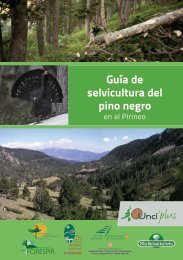Les espècies exòtiques de Catalunya
Les espècies exòtiques de Catalunya
Les espècies exòtiques de Catalunya
You also want an ePaper? Increase the reach of your titles
YUMPU automatically turns print PDFs into web optimized ePapers that Google loves.
Estrilda astrild. Foto: Wikimedia Commons<br />
OCELLS<br />
Hi ha cinc <strong>espècies</strong> d’ocells<br />
consi<strong>de</strong>ra<strong>de</strong>s invasores a <strong>Catalunya</strong>:<br />
el bec <strong>de</strong> corall senegalès (Estrilda<br />
astrild), el rossinyol <strong>de</strong>l Japó<br />
(Leiothrix lutea), la cotorra argentina<br />
(Myiopsitta monachus), la cotorra<br />
<strong>de</strong> Kramer (Psittacula krameri) i el<br />
faisà (Phasianus colchicus). La resta<br />
d’<strong>espècies</strong> <strong>exòtiques</strong> es consi<strong>de</strong>ra<br />
que encara no s’han establert al<br />
nostre territori. Algunes, però, s’hi<br />
reprodueixen <strong>de</strong> forma regular i<br />
podrien estar en fase inicial d’expansió<br />
com, per exemple, el múnia roig<br />
(Amandava amandava) o l’aratinga<br />
mitrada (Aratinga mitrata).<br />
147 <strong>espècies</strong> <strong>exòtiques</strong><br />
El 98% <strong>de</strong> les <strong>espècies</strong> s’han observat <strong>de</strong> forma<br />
ocasional, i d’aquestes, el 52% són citacions puntuals.<br />
A més <strong>de</strong> les <strong>espècies</strong> <strong>exòtiques</strong>, també hi ha<br />
onze <strong>espècies</strong> natives que han estat transloca<strong>de</strong>s.<br />
16<br />
73 <strong>espècies</strong><br />
introduï<strong>de</strong>s<br />
no establertes<br />
68<br />
invasores<br />
establertes (1)<br />
Nota: <strong>Les</strong> <strong>espècies</strong> amb estatus <strong>de</strong>sconegut es consi<strong>de</strong>ren introduï<strong>de</strong>s.<br />
5<br />
Vies d’entrada<br />
La gran majoria d’aquestes <strong>espècies</strong> han estat<br />
comercialitza<strong>de</strong>s pel seu valor ornamental<br />
i han estat introduï<strong>de</strong>s en el medi natural a<br />
través <strong>de</strong> l’alliberament <strong>de</strong>liberat o acci<strong>de</strong>ntal<br />
d’individus captius. Altres <strong>espècies</strong> han estat<br />
introduï<strong>de</strong>s pel seu interès cinegètic o per ferne<br />
ús en falconeria.<br />
84 casos<br />
60<br />
altres<br />
ocells <strong>de</strong> gàbia caça<br />
Nota: Algunes <strong>espècies</strong> po<strong>de</strong>n haver arribat per vies diferents.<br />
Regions <strong>de</strong> procedència<br />
58 casos<br />
Àfrica<br />
via incerta<br />
Àsia Austràlia<br />
41<br />
Amèrica<br />
38<br />
Nota: Algunes <strong>espècies</strong> po<strong>de</strong>n provenir <strong>de</strong> regions diferents.<br />
6 7<br />
16<br />
altres<br />
A la llista d’<strong>espècies</strong> transloca<strong>de</strong>s hem inclòs<br />
dos tipus d’<strong>espècies</strong>: <strong>espècies</strong> natives utilitza<strong>de</strong>s<br />
amb finalitats sobretot ornamentals, com<br />
ara l’ànec canyella (Tadorna ferruginea) o el<br />
cigne mut (Cygnus olor), i varietats domèstiques<br />
d‘<strong>espècies</strong> natives que han estat modifica<strong>de</strong>s<br />
per selecció artificial, i que han estat<br />
allibera<strong>de</strong>s en el medi. Aquest és el cas <strong>de</strong><br />
l’ànec collverd (Anas platyrhynchos var. domestica),<br />
o <strong>de</strong> l’oca vulgar (Anser anser var. domestica).<br />
Totes elles po<strong>de</strong>n provocar problemes<br />
d’hibridació amb les poblacions naturals<br />
d’<strong>espècies</strong> natives.<br />
7






